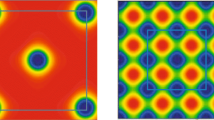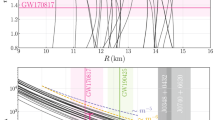Abstract
Topological structure has been extensively studied and confirmed in highly correlated condensed matter physics. We explore the gravitational waves emitted from binary neutron star mergers using the pseudoconformal model for dense nuclear matter for compact stars. This model considers the topology change and the possible emergent scale symmetry and satisfies all the constraints from astrophysics. We find that the location of the topology change affects gravitational waves dramatically owing to its effect on the equation of state. In addition, the effect of this location on the waveforms of the gravitational waves is within the ability of the on-going and up-coming facilities for detecting gravitational waves, thus suggesting a possible way to measure the topology structure in nuclear physics.
Similar content being viewed by others
References
J. W. Holt, M. Rho, and W. Weise, Phys. Rep. 621, 2 (2016).
G. Baym, T. Hatsuda, T. Kojo, P. D. Powell, Y. Song, and T. Takatsuka, Rep. Prog. Phys. 81, 056902 (2018), arXiv: 1707.04966
G. Baym, S. Furusawa, T. Hatsuda, T. Kojo, and H. Togashi, Astrophys. J. 885, 42 (2019), arXiv: 1903.08963.
L. McLerran, and S. Reddy, Phys. Rev. Lett. 122, 122701 (2019), arXiv: 1811.12503
K. S. Jeong, L. McLerran, and S. Sen, Phys. Rev. C 101, 035201 (2020).
Y. L. Ma, and M. Rho, Prog. Part. Nucl. Phys. 113, 103791 (2020), arXiv: 1909.05889.
W. Weise, JPS Conf. Proc. 26, 011002 (2019)
H. Adhitya, and A. Sulaksono, J. Phys.-Conf. Ser. 1572, 012012 (2020); T. F. Motta, P. A. M. Guichon, and A. W. Thomas, arXiv: 2009.10908.
B. P. Abbott, et al. (LIGO Scientific and VIRGO), Phys. Rev. Lett. 119, 161101 (2017), arXiv: 1710.05832.
W. G. Paeng, T. T. S. Kuo, H. K. Lee, Y. L. Ma, and M. Rho, Phys. Rev. D 96, 014031 (2017), arXiv: 1704.02775
Y.-L. Ma, H. K. Lee, W.-G. Paeng, and M. Rho, Sci. China-Phys. Mech. Astron. 62, 112011 (2019)
Y. L. Ma, and M. Rho, Phys. Rev. D 99, 014034 (2019).
Y. L. Ma, and M. Rho, Phys. Rev. D 100, 114003 (2019), arXiv: 1811.07071.
Y. L. Ma, and M. Rho, arXiv: 2006.14173.
I. Tews, J. Carlson, S. Gandolfi, and S. Reddy, Astrophys. J. 860, 149 (2018), arXiv: 1801.01923.
Y. L. Ma, and M. Rho, Effective Field Theories for Nuclei and Compact-Star Matter (World Scientific, Singapore, 2018).
Y. L. Ma, and M. Rho, Sci. China-Phys. Mech. Astron. 60, 032001 (2017), arXiv: 1612.06600.
M. Harada, and K. Yamawaki, Phys. Rep. 381, 1 (2003).
R. J. Crewther, and L. C. Tunstall, Phys. Rev. D 91, 034016 (2015), arXiv: 1312.3319
O. Catá, R. J. Crewther, and L. C. Tunstall, Phys. Rev. D 100, 095007 (2019), arXiv: 1803.08513.
Y. L. Ma, and M. Rho, arXiv: 2009.09219.
G. E. Brown, and M. Rho, Phys. Rev. Lett. 66, 2720 (1991).
Y. L. Li, Y. L. Ma, and M. Rho, Phys. Rev. C 98, 044318 (2018)
Y. L. Li, Y. L. Ma, and M. Rho, Chin. Phys. C 42, 094102 (2018), arXiv: 1710.02840.
Y. L. Ma, and M. Rho, Phys. Rev. Lett. 125, 142501 (2020), arXiv: 2002.03310.
E. Annala, T. Gorda, A. Kurkela, J. Nättilä, and A. Vuorinen, Nat. Phys. 16, 907 (2020), arXiv: 1903.09121.
J. Aasi, et al. (LIGO Scientific), Class. Quantum Grav. 32, 074001 (2015), arXiv: 1411.4547
F. Acernese, et al. (VIRGO), Class. Quantum Grav. 32, 024001 (2015), arXiv: 1408.3978
B. P. Abbott, et al. (KAGRA, LIGO Scientific and VIRGO), Liv. Rev. Rel. 21, 3 (2018), arXiv: 1304.0670; Z. Luo, Y. Wang, Y. Wu, W. Hu, and G. Jin, Prog. Theor. Exp. Phys. 116, (2020).
D. Tong, arXiv: 1606.06687.
S. K. Bogner, T. T. S. Kuo, and A. Schwenk, Phys. Rep. 386, 1 (2003), arXiv: nucl-th/0305035.
C. Y. Tsang, M. B. Tsang, P. Danielewicz, W. G. Lynch, and F. J. Fattoyev, arXiv: 1807.06571.
F. Löffler, J. Faber, E. Bentivegna, T. Bode, P. Diener, R. Haas, I. Hinder, B. C. Mundim, C. D. Ott, E. Schnetter, G. Allen, M. Campanelli, and P. Laguna, Class. Quantum Grav. 29, 115001 (2012), arXiv: 1111.3344.
M. Zilhão, and F. Löffler, Int. J. Mod. Phys. A 28, 1340014 (2013), arXiv: 1305.5299.
E. Schnetter, S. H. Hawley, and I. Hawke, Class. Quantum Grav. 21, 1465 (2004), arXiv: gr-qc/0310042.
L. Baiotti, I. Hawke, P. J. Montero, F. Löffler, L. Rezzolla, N. Stergioulas, J. A. Font, and E. Seidel, Phys. Rev. D 71, 024035 (2005), arXiv: gr-qc/0403029.
I. Hawke, F. Löffler, and A. Nerozzi, Phys. Rev. D 71, 104006 (2005), arXiv: gr-qc/0501054.
P. Mösta, B. C. Mundim, J. A. Faber, R. Haas, S. C. Noble, T. Bode, F. Löffler, C. D. Ott, C. Reisswig, and E. Schnetter, Class. Quantum Grav. 31, 015005 (2014), arXiv: 1304.5544.
E. Gourgoulhon, P. Grandclément, K. Taniguchi, J. A. Marck, and S. Bonazzola, Phys. Rev. D 63, 064029 (2001), arXiv: gr-qc/0007028.
J. S. Read, B. D. Lackey, B. J. Owen, and J. L. Friedman, Phys. Rev. D 79, 124032 (2009), arXiv: 0812.2163.
A. Bauswein, H. T. Janka, and R. Oechslin, Phys. Rev. D 82, 084043 (2010), arXiv: 1006.3315.
T. W. Baumgarte, and S. L. Shapiro, Phys. Rev. D 59, 024007 (1998), arXiv: gr-qc/9810065.
T. Nakamura, K. Oohara, and Y. Kojima, Prog. Theor. Phys. Suppl. 90, 1 (1987).
P. Colella, and P. R. Woodward, J. Comput. Phys. 54, 174 (1984).
R. De Pietri, A. Feo, F. Maione, and F. Löffler, Phys. Rev. D 93, 064047 (2016), arXiv: 1509.08804.
F. Maione, R. D. Pietri, A. Feo, and F. Löffler, Class. Quantum Grav. 33, 175009 (2016), arXiv: 1605.03424.
Author information
Authors and Affiliations
Corresponding authors
Additional information
We thank all contributors of Einstein Toolkit and LORENE code and thank Roberto De Pietri and Parma University gravity group for modifying Einstein Toolkit and developing PyCactus code and making them publicly available. We would like to thank Wei-Tou Ni for the valuable discussions we had. The work of YongLiang Ma was supported by the National Natural Science Foundation of China (Grant Nos. 11875147, and 11475071) and the Intensive Study of Future Space Science Missions of the Strategic Priority Program on Space Science. YueLiang Wu is supported by the National Natural Science Foundation of China (Grant Nos. 11851302, 11851303, 11690022, and 11747601), the Strategic Priority Research Program of the Chinese Academy of Sciences (Grant No. XDB23030100), and the CAS Center for Excellence in Particle Physics (CCEPP.
Rights and permissions
About this article
Cite this article
Yang, W., Ma, Y. & Wu, Y. Topology change and emergent scale symmetry in compact star matter via gravitational wave detection. Sci. China Phys. Mech. Astron. 64, 252011 (2021). https://doi.org/10.1007/s11433-020-1662-5
Received:
Accepted:
Published:
DOI: https://doi.org/10.1007/s11433-020-1662-5




